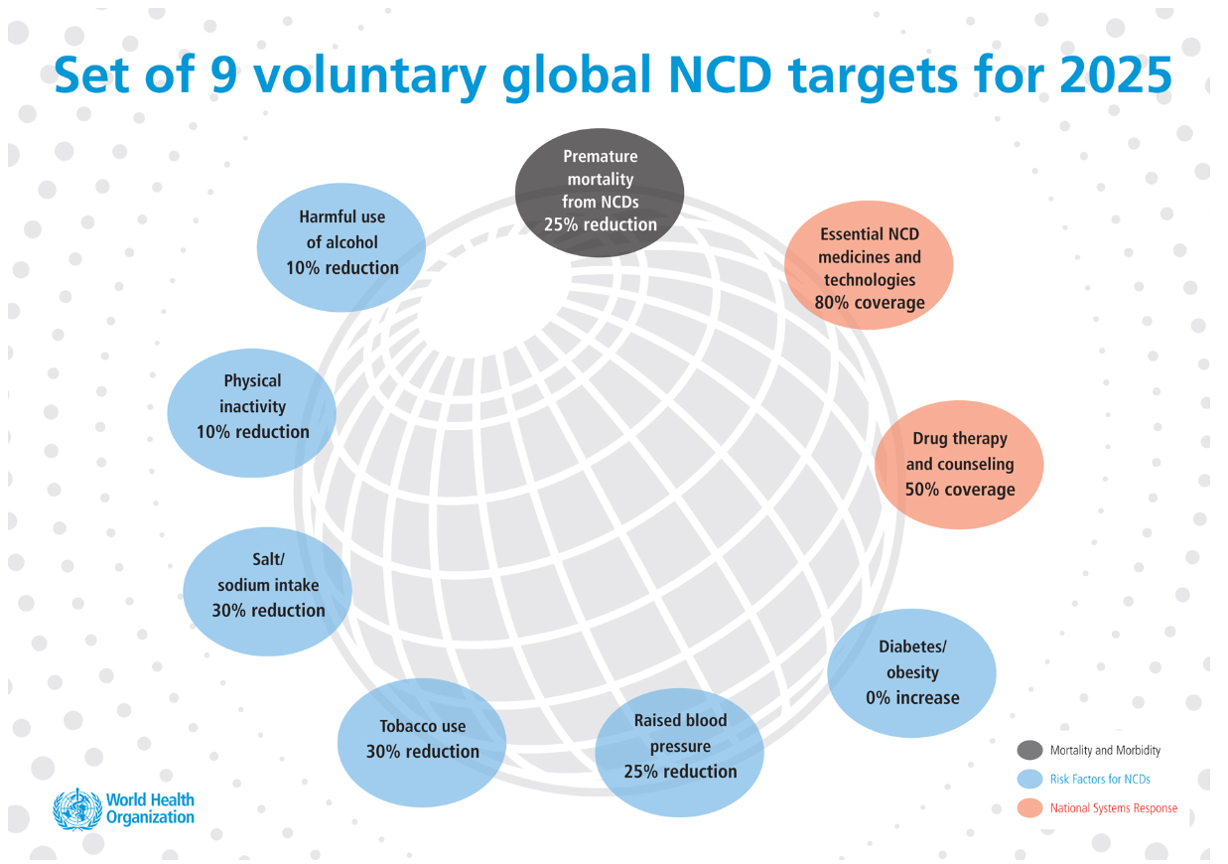Noncommunicable diseases (NCDs) and alcohol


Harmful use of alcohol is an integral part of the WHO Global action plan for the prevention and control of NCDs 2013-2030 (WHA66.10, WHA) and harmful use of alcohol is considered as one of the five key risk factors for the development of noncommunicable diseases (NCDs). Harmful use of alcohol has also been an integral part of two UN Political Declarations and one Outcome Document on the Prevention and Control of Non-communicable Diseases (A/RES/66/2, A/RES/68/300 and A/RES/73/2).
The Political Declaration of the High-level Meeting of the United Nations General Assembly on the Prevention and Control of Non-Communicable Diseases (NCDs) mandated the development of a global monitoring framework for the prevention and control of NCDs. The developed framework includes one alcohol-related voluntary global target and three alcohol related indicators of which one (alcohol-related morbidity and mortality) implies a group of indicators.
One alcohol-related voluntary global target:
At least 10% relative reduction in the harmful use of alcohol, as appropriate, within the national context.
Three alcohol-related indicators: The relative reduction in the harmful use of alcohol could be expressed in reductions in three alcohol-related indicators, which are:
- total (recorded and unrecorded) alcohol per capita (aged 15+ years) consumption within a calendar year in litres of pure alcohol, as appropriate, within the national context
- age-standardized prevalence of heavy episodic drinking among adolescents and adults, as appropriate, within the national context
- alcohol-related morbidity and mortality among adolescents and adults, as appropriate, within the national context.
The indicators of the global monitoring framework and the voluntary global targets provide overall direction for reporting on the progress achieved in prevention and control of NCDs. For achieving the voluntary target on alcohol, the Global Action Plan for the prevention and control of NCDs proposes that Member States reduce the harmful use of alcohol through the development and implementation, as appropriate, of comprehensive and multisectoral national policies and programmes as outlined in the Global strategy to reduce the harmful use of alcohol.
Appendix 3 in the NCD action plan contains a menu of policy options and cost-effective interventions for the prevention and control of major NCDs and their risk factors, including the harmful use of alcohol (WHO, 2013). Since the global action plan on NCDs was endorsed in 2013, Appendix 3 has been updated to take into consideration the emergence of new evidence of cost-effectiveness and the issuance of new WHO recommendations that show evidence of effective interventions. The updated Appendix 3 highlighting the most cost-effective interventions, renamed as “best buys”, was endorsed in May 2017 by the Seventieth World Health Assembly. Interventions included in the revised Appendix 3 were assessed for cost-effectiveness and feasibility as well as nonfinancial considerations. “Best buys” were defined as the most cost-effective and feasible for implementation interventions, with an average cost-effectiveness ratio of ≤ $I per 100 DALYs averted in low-income and lower-middle-income countries. Interventions with an average cost-effectiveness ratio of > $I per 100 DALYs averted were listed next as highly effective interventions that may be considered according to the country context. The updated Appendix 3 comprises 14 interventions to reduce the harmful use of alcohol, including three overarching/enabling policy actions, three “best buys”, two interventions with documented high effectiveness, and six other recommended interventions.
Selected publications
The SAFER technical package
Tackling NCDs: 'best buys' and other recommended interventions for the prevention and control of noncommunicable...
This document provides policy-makers with a list of ‘best buys’ and other recommended interventions to address noncommunicable diseases (NCDs)...
Global action plan for the prevention and control of noncommunicable diseases 2013-2020
The WHO Global NCD action plan 2013–2020 follows on from commitments made by Heads of State and Government in the United Nations Political Declaration...
